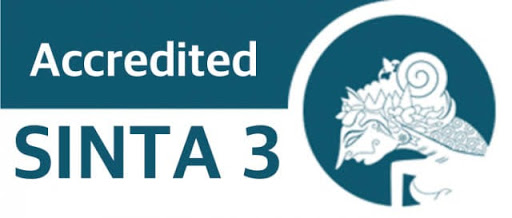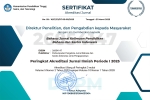Analisis Komponen Makna Tipe-Tipe Semantik Verba “Menyakiti” dalam Bahasa Jawa
Abstract
This study aims to describe: (1) the classification of the components of the meaning of the verb "hurt" in Javanese, (2) the component of the lexical meaning of the component meaning of the verb "to hurt" in Javanese, and (3) the semantic role of the verb "to hurt" in Javanese. The research method is descriptive qualitative, with a componential analysis approach to the meaning of the verb "hurt" in Javanese. The data used are primary and secondary data. Primary data is in the form of interviews with native Javanese speakers using the listening method with free-talk engagement techniques. The number of respondents was 10 respondents who came from the village of Taraman, Sindhuharjo, Ngaglik, Sleman, Yogyakarta. The selection of respondents was based on native Javanese speakers who have low mobility, so that their Javanese language skills are not contaminated by Indonesian or foreign languages. The secondary data is taken from various readings about verbs in Javanese and also uses a Javanese dictionary. The data collection technique was done by means of participatory observation. Based on the results of the research above, 34 verb lexemes of the hurting type were found in Javanese. Of these 34 lexemes are classified into 2 categories, namely "hurt" with physical and non-physical (verbal) targets. From the distinguishing elements, these two lexemes have different diagnostic components in their categories. In general, the components of the verb lexeme that hurt the target object are always living things, both human and animal, although the latter only occurs in a few words, such as "scarring", clawing. Another component of meaning in this type of area that functions as a differentiator between one vocabulary and another is the components of general objects and specific objects of tools and methods. Based on the type of meaning, there are 8 subcategories of the type of meaning, namely injuring by leaving a mark, pressing, throwing, pushing, stabbing, pinching, twisting, and bumping. Each lexeme has meaning within the subcategory, but differs in its additional components. Other components of meaning that often function as distinguishing characteristics are the object component (general objects, special objects), method, tool, place, time of purpose, and intentional (intentional or unintentional). The presence of the affix form is also very likely to affect the shift in meaning. However, in this study, we have not seen a shift in the semantic meaning of these lexemes. and intentional (intentionally or unintentionally). The presence of the affix form is also very likely to affect the shift in meaning. However, in this study, we have not seen a shift in the semantic meaning of these lexemes. and intentional (intentionally or unintentionally). The presence of the affix form is also very likely to affect the shift in meaning. However, in this study, we have not seen a shift in the semantic meaning of these lexemes.
Keywords
Full Text:
PDFReferences
Alwi, Hasan. (2005). Kamus Besar Bhasa Indonesia. Jakarta: Balai Pustaka.
Alwi, Hasan. (2010). Tata Bahasa Baku Bahasa Indonesia. Jakarta: Balai Pustaka.
Cruise, D.A. (1986). Lecsical Semantic. Cambridge and New York: Bambridge University Press
Chaer, Abdul. (2013). Pengantar Semantik Bahasa Indonesia. Jakarta: Rineka Cipta
Kridalaksana, Harimurti. (2009). Kamus Linguistik. Jakarta: Gramedia
Lyons, J. (1977). Semantics. London and New York: Cambrigde University Press. https://doi.org/-10.1017/CBO9781139165693
Nardhiati, Sri. (2017). Komponen Makna leksem Berkonsep Empon-Empondalam Bahasa jawa. Widyaparwa, 45(2). https://doi.org/10.26499/wdprw.v45i2.233
Nida, Eagene, A. (1975). Componential Analysis of Meaning: an Introdudtion to Semantics Structure. The Hague: Mouton.
Nurlina, Wiwin Erni Siti. (2017). Kosakata Berkonsep Makna Ingin dalam Bahasa Jawa. Dalam Martabatkan Bahasa dan Sastra Rayakan Kebhinekaan. Ambon: Kantor Bahasa Maluku.
Pateda, Mansoer (2010). Semantik Leksikal Jakarta: Rineka Cipta.
Pranowo, N. F. N., & Firdaus, W. (2020). Penggunaan Bahasa Nonverbal dalam Upacara Adat Pernikahan Gaya Yogyakarta: Kajian Simbolik Etnopragmatik. Ranah: Jurnal Kajian Bahasa, 9(1), 35-55.
Sudaryanto, (1986). Metode Linguistik. Yogyakarta: Gadjah Mada University.
Subroto, D. Edi. (1988). Perian Semantik Kata-Kata yang Berkonsep Membawa dalam Bahasa Jawa. Makalah Konfrensi dan Seminar Nasional Masyarakat Linguistik Indonesia: Ujung Pandang.
Sukesti. Restu. (1993). Kata Kerja tipe Menyakiti kepala dan Bagiannya. Widyaparwa, 40(2).
Tim Balai Bahasa Yogyakarta. (2011). Kamus Basa Jawa (Bausastra Jawa). Yogyakarta: Penerbit Kanisius.
Wedhawati. (1998). Medan Leksikal Verbal Indonesia yang Berkomponen Makna Suara Insani, (disertasi). Yogyakarta: Universitas Gadjah Mada.
Wedhawati. (2005). Konfigurasi Medan Leksikal Verbal Indonesai yang Berkomponen Makna. Humaniora, 6(1).
Wijana, I Dewa Putu. (2008). Semantik: Teori dan Analisis. Yogyakarta, Surakarta: Perbit Yuma Pustaka
Zulfahita, Lili Yanti, Evi Purnawati. (2019). Analisis Komponen Makna Verba "Menyakiti" dalam Bahasa Melayu Dialek Sambas (kajian Semantik). Jurnal Pendidikan Bahasa dan Sastra Indonesia, 4(2). https://doi.org/10.26737/jp-bsi.v4i2.1087
DOI: https://doi.org/10.26499/bahasa.v4i2.289
Refbacks
- There are currently no refbacks.

This work is licensed under a Creative Commons Attribution-NonCommercial-ShareAlike 4.0 International License.
This work is licensed under a Creative Commons Attribution-ShareAlike 4.0 International License.
Apartemen Suite Metro
Jalan Soekarno Hatta No. 698B, Kelurahan Jatisari - Kecamatan Buahbatu Bandung, Jawa Barat 40286
























